Annually, CCEL co-hosts MSU's Undergraduate Research Symposium with the Shackouls Honors College. The Symposium features faculty-guided, student-led research efforts from diverse departments, colleges, and research centers across campus. In recognition of Mississippi State University's Carnegie Community Engagement Classification, a Community Engagement track is included in the symposium. Faculty judges from multiple disciplines review and score the engagement projects. Abstracts and photos of the winners of the Community Engagement Track are featured below. For additional information about future undergraduate research symposium dates, please visit http://www.honors.msstate.edu/research.
First Place – Arts & Humanities
Student: Sara Peppers
Major: Landscape Architecture
Faculty Advisor: Peter Summerlin, Department of Landscape Architecture
Co-Author(s): Zack McWilliams
Project Title: Return to Nature - Locating Wolf River Nature Camps
(show abstract)
Abstract: As major cities around the country continue to grow, there are increased efforts to establish and expand outdoor recreation camps within these metropolitan areas. Engagement with nature at an early age promotes a healthier cognitive development and can serve as a foundation for environmental literacy for future generations. At the same time, the protection and preservation of forested habitats for our cities is crucial as urbanization puts pressure on the remaining wilderness. It is with this in mind that this project seeks to target potential sites for new outdoor recreation camps within the Wolf River Watershed in Memphis, Tennessee and serve as a model process for future nature camps in metropolitan areas. Initial stages of the project documented similar camp types outside of the Memphis region to serve as precedent for the proposed camp identities. The camps observed take advantage of nature museums, botanic gardens, arboretums, and the like and used them as bases for overnight camping, canoe trips, outdoor survival, and other topics. From these and other ideas, the design team established a range of camp types to distribute across the watershed. To locate these camps, the design team developed a methodology to target 3 unique types of camps within the watershed:
urban, adventure, and science-driven camps. The methodology looked at 5 pieces of data for the 3 camps; roads, streams, landcover, natural areas, and schools. Each piece of data was reclassified in relation to each camp in order to prioritize certain elements of the data. The design team used this weighted data along with manual overlays, again, dependent on the specific camp typology, to help find the optimal site for the 3 unique nature camps. Related infrastructure like medical care was also taken into account when determining the most optimal site among the results.
First Place – Biological Sciences and Engineering
Student: Javad A'arabi
Major: Biological Sciences/Microbiology
Faculty Advisor: Dr. Chinling Wang, CVM Basic Science Department
Co-Author(s): Hsin-Yi Lu, Wenyuan Yang, Yue-Jia Lee
Project Title: Adopting Lactobacillus Species and Organic Acids as Alternative Treatments to Necrotic Enteritis
(show abstract)
Abstract: Necrotic enteritis (NE), caused by Clostridium perfringens (CP), is a re-emerging disease that costs a six-billion-dollar deficit to the global poultry industry. Low level usage of antibiotics added to animal feed as a growth promoter has been shown to be an effective measure to control disease. Due to the extensive belief of antibiotic resistance bacteria transferring to humans, many poultry companies have removed growth promoters from poultry feed, resulting in an increase incidence of necrotic enteritis. Therefore, an alternative treatment without using antibiotics to treat this disease is critical for the survival/profitability of the poultry industry. Lactobacillus species have been shown to improve the gut integrity of humans and animals to compete against pathogens. The hypothesis was that the use of beneficial bacteria can inhibit the growth of harmful bacteria in the chicken gut. The objective of this study was to evaluate the effectiveness of probiotics bacteria, Lactobacillus johnsonni and Lactobacillus salivarius, to protect chickens against CP. In the experimental design, broiler chicks were divided into four groups: A) positive control, B) L. Johnsonni treatment, C) L. salivarius and D) negative control.
Groups A to C were challenged with CP. The results showcased that the L. johnsonni or L. salivarius supplement did not protect birds against the CP challenge. Orally giving probiotics daily seems to introduce stress to the birds and increase the susceptibility of CP, resulting in higher mortality and intestinal lesions than the positive control group (challenged but no probiotics). The conclusion is that neither L. johnsonii nor L. salivarius protects chickens against the CP challenge. A different methodology of administering the probiotics to avoid stress to chickens, such as mixing in feed, water, or a mixture of beneficial bacteria and organic acids, should be considered for future studies.
First Place - Physical Sciences and Engineering
Student: Blade Hodges
Major: Agricultural Engineering Technology & Business
Faculty Advisor: Dr. Mary Love Tagert, Department of Agricultural and Biological Engineering
Co-Author(s): J.O. Paz, D. Reginelli
Project Title: : Evaluating In-Field Soil Moisture Variability with Sensors
(show abstract)
Abstract: There have been numerous studies on soil moisture as it pertains to irrigation in Mississippi, but more work is needed in Blackland Prairie, located in the northeastern part of Mississippi. Here, an increasing number of producers are showing an interest in irrigation. It is not economical to access groundwater over most of the region due to the depth of the aquifer, so many producers use surface water for irrigation. Sprinkler irrigation is the primary application method, to accommodate the changing topography across the landscape. Soil moisture sensors have been shown to conserve water usage while maintaining yields on irrigated fields, helping to better time irrigation applications with crop water needs. However, the ideal number of sensor sets needed over a given area and the best placement of sensors within a field needs to be determined. There are many variables that can affect soil moisture including topography, soil type, and the variability of vegetation. This study is being executed on a 15-ha soybean field under sprinkler irrigation near Brooksville, MS. A 55-m grid was placed over the field, resulting in 44 sample locations. Watermark Granular Matrix soil moisture sensors were installed at 12- and 24-inch depths at each sampling point and were connected to data loggers which recorded data hourly. Plant height and leaf area index (LAI) were measured weekly from June 29 through August 17, 2018. Soil texture was measured for each grid point, showing a relatively homogenous field with a silty clay loam as the dominant soil type. Results show spatial differences in soil moisture over time, with more variability when the soil profile is drier. At most sensor locations, plant height had a higher correlation than LAI to soil tension.
First Place – Social Sciences
Student: Emily McCabe
Major: Biological Engineering
Faculty Advisor: Dr. Alta Knizley, Mechanical Engineering
Project Title: : : Making a Mentor: Cultivating Outreach Culture and Soft Skill Development in Engineering
(show abstract)
Abstract: Engineering education and outreach has been a topic of interest for both K-12 programs and universities across the country. There’s a high demand for STEM positions, and companies are trying to recruit not only capable candidates, but diverse and engaged employees. It is important to not only create effective K-12 programs, but also to engage college students as they approach the job market. While many K-12 programs exist in varying forms, there has been an ongoing conversation about their short-term and long-term impacts. There is evidence that supports the necessity for well-trained, enthusiastic mentors to run these K-12 outreach programs. The need to engage and develop college students and the need for engaging mentors for K-12 students work in an interdependent cycle, where strengthening mentors also strengthens the K-12 student experience. The purpose of this study is to examine best practices for engineering mentor development in order to improve efficacy of outreach programs while simultaneously improving the skillsets of engineering students. Focuses will include the impacts of training mentors from a personal development view, as well as assessing their success as mentors during a K-12 outreach program in place at Mississippi State. There will also be an assessment to determine whether these diverse, trained mentors impact the efficacy of the program and how they impact the participants. Surveys will be conducted throughout this process to evaluate attitudes and skill sets of a core team leading the event and of faculty, student mentors, and K-12 participants. Observations will also be noted from training sessions and outreach sessions to help assess improvement from past years of outreach events. Initial survey results from faculty and student volunteers indicate that soft skill development for engineering students is needed, and observations from core team suggest that mentorship can be improved through training.
First Place
Student: Laura Herring
Major: International Business
Faculty Advisor: Dr. Kathleen Ragsdale
Project Title: Exploring Food Insecurity Congruence among Husband-Wife Dyads Using the Household Hunger Scale: Occasional, Moderate, and Severe Hunger among Small-scale Men and Women Farmers in Rural Ghana
(show abstract)
Abstract: Ghana’s Northern Region—where approximately 73.5% of adults are smallholder farmers—experiences high rates of poverty, food insecurity, and childhood malnutrition (Ghana Statistical Service, 2013; Malapit & Quisumbing, 2014; Quaye, 2008). The USAID-funded Feed the Future Soybean Innovation Lab’s research in Ghana’s Northern Region is focused on assisting smallholder men and women farmers towards improved food security and sustainable agricultural production.
As part of a larger survey, we administered the six-item Household Hunger Scale (Ballard et al., 2011) to men and women farmers in the Northern Region—of whom the majority were husband-wife dyads—to assess dyad congruence for reported household-level hunger (HLH). The scale categorizes HLH in the past 4 weeks as occasional (1-2 times), moderate (3-10 times), or severe (≥11 times) for three Hunger Events: 1) No food to eat of any kind in the household due to lack of resources to get food, 2) Household member(s) went to sleep at night hungry because there was not enough food, and 3) Household member(s) went a whole day and night without eating anything because there was not enough food.
Husband-wife dyads comprised 93.7% of the sample (N=675). Over 30% reported Hunger Event 1 in the past 4 weeks 1-2 times (19.1%), 3-10 times (11.6%), or ˃10 times (2.1%). Nearly 29% reported Hunger Event 2 in the past 4 weeks 1-2 times (16.8%), 3-10 times (11.4%), or ˃10 times (2.8%). Nearly 23% reported Hunger Event 3 in the past 4 weeks 1-2 times (11.6%), 3-10 times (10.3%), or ˃10 times (2.9%). For all three Hunger Events, females were more likely to report occasional HLH. Males and females were equally likely to report moderate and severe HLH. Results suggest the Household Hunger Scale is an appropriate measure for cross-cultural use to assess HLH in food-insecure regions.
Second Place
Student: Leah Gann
Major: Horticulture
Faculty Advisor: Dr. Tongyin Li
Project Title: Use of the MSU Community Garden as a Living Base for Teaching, Research, and Outreach Programs
(show abstract)
Abstract: A case study was conducted to investigate the use of the MSU Community Garden as a living classroom for teaching, research, and outreach programs. The Mississippi State University Community Garden initiated its first planting in April, 2017. Designed by associate professor Cory Gallo’s landscape architecture design/build studio, twelve raised beds were designed and built in the garden. Construction of the MSU community Garden is planned to be complete in 2018 with a total number of 30 beds and an orchard. From a teaching standpoint, three courses including the Gardening Experience (PSS 1113), Grow Your Own Salads and Soups: Vegetable Gardening (LA 1001), and Community Food Systems (LA/PSS/FNH 4990/6990) are using the community garden as experiment site, where students gain hands-on experience of growing vegetables. At the MSU Community Garden, students can volunteer to work in the garden and serve as creative outlets for them. The Community Garden also serves as a base for graduate and undergraduate student research. The garden is available to student, staff, and faculty members in MSU and to Starkville citizens and serve for demonstration purposes of new and sustainable gardening practices. The community garden provides opportunity to involve people of all ages in
promoting inspiration for gardening and a sense of pride in the work that is accomplished there. Therefore, the community garden is making an impact for people in and outside MSU by increasing health consciousness of the community and promoting a healthy local food system.
First Place
Student: Taylor Watson
Major: Human Sciences/Human Development and Family Studies
Faculty Advisor: Dr. Julie Parker
Project Title: The Effect of Equine Assisted Activities on the Social Functioning in Children with Developmental Disabilities
(show abstract)
Abstract:
Many young children with developmental disability are characterized by impairments in social function skills (communication, interaction, and behavioral control). Equine Assisted Activity (EAA) and Therapy programs are considered a complementary and alternative medicine (CAM) treatment program facilitated to address the physical and social needs of children with developmental disability.
To date there have been limited studies that focus on the impact of equine assisted activities (EAA) for social functioning in young children with disabilities. EAA have been used to treat individuals with physical and intellectual disabilities and may have a positive impact on negative behaviors by promoting sensory regulation, self-efficacy, and communication skills for the participant (Bass et al., 2009; Cuypers et. al., 2011; David, 2007). EAA is thought to be beneficial because it incorporates human-animal interaction, cognitive-behavioral-based stress management, and physiological relaxation techniques into the programing. The purpose of this research was to explore the effects of EAA on social functioning and sleep hygiene for a child with developmental disability. The subject of this case study presented with Autism Spectrum Disorder (ASD) and had never participated in an EAA program prior to the study. This case study utilized multiple methods to gain an in-depth perspective on the benefits of participation in equine assisted activities and therapeutic riding. Three forms of data were collected including a sleep diary, the Sensory Profile, and qualitative process notes. Results from this study were mixed but showed that there is a need for further research using both qualitative and quantitative measures.
First Place
Student: Audrey Sanderson
Major: Elementary Education
Faculty Advisor: Kathleen Alley
Project Title: Professional Development to Support Familiarity and Use of Instructional Strategies in the Middle Level Classroom
(show abstract)
Abstract: Professional Development to support Familiarity and Use of Instructional Strategies in the Middle Level Classroom Audrey Sanderson This Study Investigates the influence of an intensive, month-long teacher institute on participants’ familiarity with the use of research-based instructional strategies. SSILTT: Science and Social Studies Integration with Literacy and Technology was a professional development program for middle level educators that took place in June 2014, with two follow up sessions provided during the 2014-2015 school year.
Workshop goals were to help teachers: (1) increase academic rigor and their use of CCSS to design instruction in literacy and in the content areas, including the infusion of research-based instructional strategies, (2) increase students’ use of argument critical thinking, listening and speaking, and writing skills required for the CCSS, (3) increase teachers’ use of technology, including multimodal and visual literacy, and (4) create developmentally responsive learning experiences, promoting motivation at the middle level. Quantitative and qualitative methods were used to investigate participants’ familiarity with and use of research-based instructional strategies. Data sources I used in this investigation included an instructional strategy questionnaire of teachers’ knowledge of instructional strategies, given pre and post intervention; and, transcriptions of focus group discussions conducted during the June institute and follow up sessions. Statistical analysis indicated there was a significant difference in participant familiarity with strategies before the training and after. Paired-samples t-test results comparing participant self-reported use of strategies before the training were significant. Qualitative analysis of transcribed focus group discussions supported quantitative analysis, indicating teachers felt the professional development they received supported their increased familiarity with instructional strategies they then included more frequently when planning for and implementing instruction. Further, teachers stated they believed their increased use of these instructional strategies supported students’ academic achievement.
Second Place
Student: Anna Barr
Major: Architecture
Faculty Advisor: Alexis Gregory
Project Title: Continuing to Improve on Outreach Design
(show abstract)
Abstract: The field of architecture hast opportunity and responsibility to serve the community. Architects are challenged with catering to the needs of specific communities, such as the Oxford-Lafayette area, while also improving the residents’ quality of living. I conducted continued research for the Habitat for Humanity of Oxford-Lafayette area, taking house designs developed through a collaborative research project. The original research was conducted by me and two other architecture students in Fall 2014/Spring 2015 and funded by an Oxbridge Tutorial. The research team conducted preliminary research into previously constructed Habitat for Humanity houses, building code, zoning requirements, ADA and egress requirements, and site analysis, including solar orientation and wind direction. The team then brought in student volunteers from the American Institute of Architecture Students (AIAS) to participate in a 4 hour design service-learning immersion project. The purpose of this design project was to establish a relationship between the students and the community for the betterment of both through equal cooperation. This current project used AIAS student designs to create construction drawings to make the house designs fully useable. To do this, I created mechanical and plumbing drawings, further developed the floor plans, and drawing details for the physical construction of the houses. The continuation of this project will further the efficiency and cost effectiveness of the houses. This project will not only give Habitat for Humanity the designs for two homes, but these houses will also serve as prototypes for the betterment of Habitats overall outreach goals of making better designed homes available to low income families. The implementation of our prototype houses will help enrich the community through the influence of better designed low income housing.
Third Place
Students: Christine Dunn
Major: Secondary Education
Faculty Advisor: Judith Ridner
Project Title: A Shake Truce: Starkville Civil Rights
(show abstract)
Abstract: This project sought to identify key terms and themes present in interviews of members of the Starkville community present during the integration of education. These interviews were conducted by researcher’s part of the “A Shaky Truce” project. In order to identify these terms and themes, the researcher listened to, partially transcribed, and annotated several key interviews. Using these partial transcriptions and annotations, as well as the notes taken by other researchers in the project, the researcher identified events and themes that appeared in multiple interviews. Once these themes had been identified, the researcher created lesson plans for the Starkville Civil Rights website, highlighting illustrative interview segments for teacher’s use in the secondary education classroom.
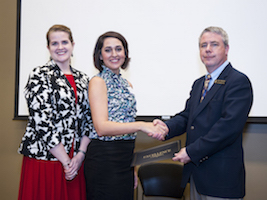
First Place
Student: Heather Lyles
Major: Anthropology
Faculty Advisor: Toni Copeland
Project Title: Creating a Better Tomorrow: A Service-Learning Project in Starkville, Mississippi.
(show abstract)
Abstract: Community is a concept that includes family and friends, local businesses, schools, services, and even sporting events. Being a part of a community is a key factor in creating, sustaining, and developing the social well being of its people.
Often it is the adults' opinions and beliefs that shape the future of any community; children are rarely asked for their input. Their voices and hopes for the future of a community are seldom heard. Objective: Creating a Better Tomorrow Together is a service-learning project (SLP) committed to documenting elementary school children's perspectives on the community of Starkville, MS. Methods: Graduate students visited local elementary schools and asked fourth graders at those schools to reflect on Starkville today, to design their ideas for an ideal future community, and to portray these in artwork. Elementary school students accomplished this by drawing and creating pictures of many elements associated with the community of Starkville. Key Findings to Date: These pictures were used to create a coloring book to give back to the kids, a full color book to give back to the schools and community, and an instruction manual for others who wish to perform similar service-learning projects. The service-learning project focuses on initiated change within the community, especially community cohesiveness through children's eyes as well as empowering these children. It also encourages community engagement and partnerships between schools, higher education, and various community members.

Second Place
Student: Shelby Hayes
Major: Agricultural Economics
Faculty Advisor: Matthew Freeman
Project Title: Communication Avenues for Vietnamese-American Fishing Communities in Mississippi and Alabama with Coastal Resource Agencies
(show abstract)
Abstract: Vietnamese-American fishers are a large proportion of the shrimping population and seafood industry workers in the Mississippi-Alabama Gulf Coast, and a high level of fisheries resource dependency exists among the Vietnamese American community in the MS-AL Gulf Coast. These communities have faced extreme environmental and economic shocks in the recent past which has increased the urgent need for effective communication among Vietnamese American fishers and diverse agencies and successful dissemination of information to the Vietnamese-American community on the MS-AL Gulf Coast. These shocks highlighted the importance of effective agency communication and outreach to bolster community economic, environmental and sociocultural resiliency. This project is focused on identifying socioeconomic factors that encourage/discourage communication between Vietnamese-American communities and coastal resource agencies. The three main objectives of the project are to: identify existing channels and barriers for communication among community and agencies regarding regulatory, environmental and health risk information; identify key nodes within existing community communication networks; and promote research partnerships with community organizations and among agencies. Our research sites are Biloxi, MS and Bayou La Batre, AL because they exist within the same Sea Grant agency and federal agencies yet have different state agencies and local communities. This allows for comparison across more diverse agency/community relationships. Using interviews with state and federal agencies, community associations, and focus groups with members of the fishing community, we aim to develop a survey measurement tool for use in further assisting and improving communication avenues between Vietnamese-American fishing communities and state/federal agencies in Mississippi and Alabama. The created measurement tool will be available for use and modification for other ethnic coastal fishing communities.

Third Place
Students: Patrick Brown, Anna Barr, and Lucas Posey
Major: Architecture
Faculty Advisor: Alexis Gregory
Project Title: Improving on Outreach Design
(show abstract)
Abstract: The field of architecture has the opportunity and responsibility to serve the community. Architects are challenged with catering to the needs of specific communities, such as the Oxford-Lafayette area, while also improving the residents' quality of living. Developing the ability to fulfill the needs of clients while also improving the community begins in education. This research uses a service-learning project spanning over two semesters combined with a brief 4-hour service-learning immersion. Through service-learning, students have the opportunity to gain real-world knowledge of their specific field through serving a community with programs such as Habitat for Humanity. This begins with establishing the specific requirements set out by the client and using those requirements to create more efficient and sustainable designs. The research team conducted preliminary research into previously constructed Habitat for Humanity houses, building code, zoning requirements, ADA and egress requirements, and site analysis, including solar orientation and wind direction. The team then brought in student volunteers from the American Institute of Architecture Students (AIAS) to participate in a 4-hour service-learning immersion project. The purpose of this project was to establish a relationship between the students and the communities for the betterment of both through equal cooperation. The end goal of this research is to better the designs of two cost effective homes. These designs will provide an example for future Habitat for Humanity projects of good design in low-income housing. Placing good design practices in the reach of low-income families will better the quality of living and increase the benefits of the home, making it more affordable in the long run. The involvement of the students will raise awareness through the design charette about extending opportunities to low-income families and improving communities in the long run.
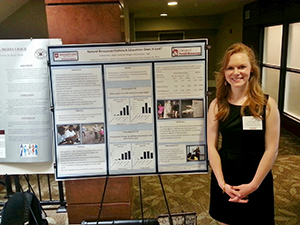
First Place
Student: Katherine Abell
Major: Wildlife & Fisheries/Wildlife Science
Co-Authors: Dr. Jessica Tegt
Faculty Advisor: Leslie Burger
Project Title: Natural Resources Outreach Education: Does It Last?
(show abstract)
Abstract: Outreach programs are a common approach used to introduce young people to natural resources management and conservation issues. However, their ability to produce long-term changes in environmental attitudes in participants is largely unknown. We administered a 10-item, 3-demensional, validated survey instrument – the New Ecological Paradigm Scale for Children – to a diverse population of 6th- and 7th-grade students in a small, rural town in Mississippi. The objective of the project was to determine the students’ environmental attitudes 1- to 2-years after participation in a school-based, natural science program. Analysis of usable surveys (n=106) indicated no significant change in student attitudes one year later, suggesting attitude retention. Also, those who had participated in the environmental program during 2 grades exhibited scale dimension values that were more environmentally positive (x Ì… = 3.63) than those who had only been in the program once ( x Ì… = 3.32, p = 0.04). However, significant declines in scale dimensions were detected in those students who were 20years post-program. Additionally, a negative shift in environmental attitudes was observed in 9 of the 10 scale items between 1- and 2-years post-program. Results of this study suggest positive gains from natural science programs are retained, but in the absence of reinforcement, will begin to decline after an extended period of time.
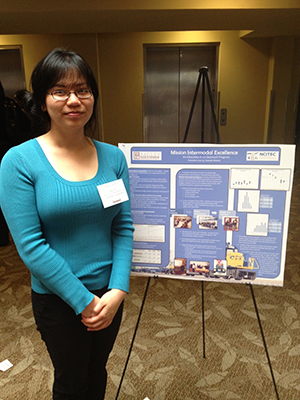
Second Place
Student: Lucy Ly
Major: Industrial Engineering
Co-Authors: Christina McDaniel, N. Eric Heiselt, Burak Eksioglu, and Davonta Whalum
Faculty Advisor: Sandra Eksioglu
Project Title: Mission Intermodal Excellence
(show abstract)
Abstract: The focus of this presentation is a year-long educational program delivered to K-12 teachers through the College of Engineering. The objective is to introduce K-12 teachers and students to intermodal transportation. The program started during the summer with a short course to train the teachers. During this training, teachers worked on developing lesson plans and hands-on activities. The teacher delivered these lesson plans to their classrooms during the academic year. The students of participating teachers participated in a related Public Service Announcement (PSA) competition. A PSA is a “commercial” to teach the audience something important. The summer training consisted of in-class instruction. More specifically, the following topics were covered: transportation safety, traffic flow, transportation emissions, transportation cost analysis, etc. A number of field trips to intermodal facilities were organized. Experts from industries in Mississippi visited the classroom and discussed related topics such as the intermodal operations at the port of New Orleans, intermodal activities at the FedEx hub, managing the school bus schedule in Starkville school district, etc. We conducted a survey and collected data in order to evaluate the impact that the in-class instructions, field trips and hands-on activities had on improving teachers understanding on intermodal transportation. The results of the survey indicate that, teachers understanding of intermodal transportation and related issues improved drastically. For example, of the 17 teachers surveyed prior to the workshop, only 3 knew what the term intermodal transportation is, 4 confused the definition of intermodal with intra-modal transportation, and 10 did now know. Similar improvements are observed amongst students as well. The result from the PSA competition indicates an increased awareness among students about transportation safety, and transportation-an-environment.
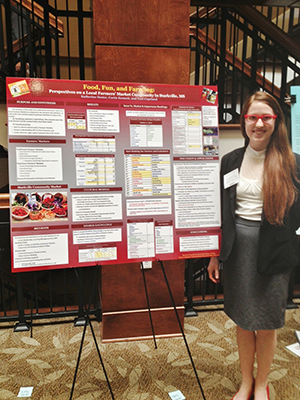
Third Place
Student: Katherine Hester
Major: Anthropology
Co-Authors: Curtis Kennett
Faculty Advisor: Toni Copeland
Project Title: Food, Fun, and Farming: Perspectives on a Local Farmer’s Market community in Starkville, MS
(show abstract)
Abstract: Farmer’s Markets are a source of fresh, quality fruits and vegetables as well as social and community connections. They also support local, small farms while providing customers with alternative shopping experiences as compared to grocery stores. In order to sustain markets, customers must be motivated to shop there which often entails an understanding of the benefits of the markets. This project explores the motivations of customers shopping at a local Farmer’s Market. This includes the reasons they choose to shop at stores or frequent the market, expectations, and desired improvements or additions. These are compared to farmers’ perspectives. Specifically, we compare how much farmer and customers agree on the benefits of the market, the importance of different aspects of the market, and how they would like to see the market develop in the future. Using both qualitative and quantitative research methods, we found that there is a shared cultural model of the benefits of Farmer’s Markets among patrons and famers. There is, however, a great deal of variation in how much they agree on specific qualities. For example, farmers have a very different view of what improvements are needed and even whether or not they are needed to provide a better experience for customers. This research is being supplied to the Farmer’s Market to facilitate a better understanding of what customers want from the market. This will assist the farmers and the market in maintaining current customers and growing in the future.
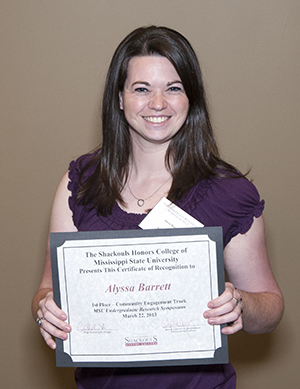
First Place
Student: Alyssa Barrett
Major: Agricultural Science
Co-Authors: Dr. Mike Oye, Dr. Gaea Wimmer, Dr. Ned Browning
Faculty Advisor: Dr. Ned Browning, School of Human Sciences
Project Title: Development of Extension Programs in Nigeria: A Case Study
(show abstract)
Abstract: Research has shown there is a high correlation between the location of Moringa oleiferas natural environment and the places where malnutrition and hunger are most prevalent. Moringa oleifera is a shrub-like tree that grows in tropical and sub-tropical environments. The fruit, flowers, leaves, and sap of the Moringa tree are used for their dietary and medicinal value for humans. Under the direction of Dr. Mike Oye, a Nigerian educator, I am observing how Moringa oleifera is being re-introduced and adopted by the people of Abakaliki, Nigeria. During spring semester 2013, as part of a mission trip, I will be observing Dr. Oye’s development work in utilizing a native plant to help alleviate hunger. My research objective will be focused on the diffusion of the innovation (Moringa oleifera) and the adoption process. As a student concentrating on agricultural extension education, I hope to gain a better understanding of the methods used to introduce a crop as a marketable product and how people adopt the new crop. I am also observing how people react to and learn a new practice. The research design will consist of a case study focusing on the adoption of the Moringa oleifera as a medicinal and profitable agricultural commodity. I will ask questions to those directly involved in the dissemination of this innovation and those adopting it. I will also keep field notes and reflect on observations made during my time in Nigeria. Other research questions will emerge from the research process. Upon returning to Mississippi I will transcribe my field notes and responses to questions asked of those I interviewed. I will analyze the results through the constant comparative method to identify themes to answer my research questions.
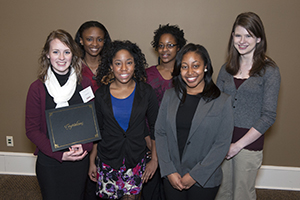
Second Place
Student: Rebecca Cash
Major: History
Co-Authors: Andrea Drake, Brittany Henderson, Karissa Logan, Randi Manning, Austin Walthall, and Shawna Williams
Faculty Advisor: Amy Fountain, Communications
Project Title: Super Readers: Meeting Literacy Needs in our Starkville Schools
(show abstract)
Abstract: According to the Social Science Research Center, 78% of Mississippi's fourth graders performed at a below proficient reading level, resulting in a national ranking of 48 in 2009. Unfortunately, the trend continues as the students advance, as 74% of third graders who perform poorly in reading will continue to do so into high school. While participating in the Day One Leadership Community we began to realize the literacy needs in our community, especially among elementary school students. After being paired with the Sudduth Elementary School’s library, we worked with students and began to seek ways to increase interest in reading at an early age. Using the school’s mascot and the concept of super heroes which interested young readers, we created a book that encouraged pursuing higher education and exploring various careers. We incorporated vocabulary words included in the school’s curriculum to reinforce what they were learning in the classroom. To cultivate excitement about the book, we had several students draw specific scenes and characters to include as illustrations. We experienced the children’s excitement about their work when we presented nineteen copies of the book to the library. In addition to writing the book, we visited the school weekly to spend time with the children and personally instill an interest in reading. Over the course of the fall 2012 semester, we individually worked with approximately 66 students in 110 hours.
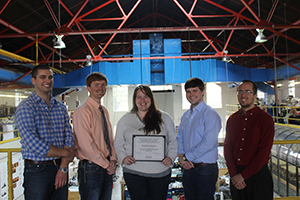
Third Place
Student: Melinda Ingram
Major: Architecture
Co-Authors: Alex Reeves, Jake Johnson, Mark Riley, Adam Troutman, Dr. April Heiselt
Faculty Advisor: Alexis Gregory, Architecture
Project Title: Elevating Habitat: Service-Learning in Construction and Design
(show abstract)
Abstract: Organizations such as Architecture for Humanity, Architects Without Borders and other non-profit architecture design organizations are interested in service-learning to aid those throughout the world that have been affected by poverty, war and natural disasters. The students working on this research worked with the Starkville Area Habitat for Humanity to design the upcoming Maroon Edition 2013 house to be constructed in the fall semester of 2013. The class was composed of students from the School of Architecture and the Department of Building Construction Science. Students met and worked directly with the future homeowners for the house in addition to members of the Starkville Habitat for Humanity board. The research studied the effects of service-learning on Millennial students working on architecture design and construction. The students worked as a team to design the house, as well as create the construction drawings that will be needed to order materials and construct the house. Students developed critical professional skills in addition to the design skills inherent in architecture education. These include the ability to utilize modular materials for construction detailing to limit the expense of the house construction, the ability to complete a construction budget estimate to help provide guidance on the expense of the construction of the student design, and the ability to complete a construction schedule for the project to understand the time implications of design for a non-profit client. The service-learning aspect of the research exposed students to a new way of learning and looking at an architectural design and construction project. They were able to partner with a real-world client, not just imagine how to work with them. This helped the students better understand the needs of their client, and the community. A more developed sense of the effects of architecture as service was achieved through the student research.








